Understanding the Hierarchical Relationships in Female Sex Workers’ Social Networks Based on Knowledge, Attitude, and Practice
Abstract
1. Introduction
2. Materials and Methods
2.1. Data
2.2. Methodology
2.2.1. Division of Individual Characteristics
Interview Questions
The Division of Node Attribute
2.2.2. Construction of Multi-Layer FSW Social Network Model
FSW Social Network
Multi-Layer FSW Social Network
Positive and Negative FSW Social Sub-Networks
3. Results
3.1. Measuring the Association between Responses to Knowledge, Attitude, and Practice
3.2. Measuring Neighbor Impact on an Individual in a Single Layer
3.3. Measuring Neighbors’ Influence on an Individual in the Multi-Layer Network
3.3.1. Positive and Negative Neighbors
3.3.2. Neighbors’ Influence on Positive FSWs
3.3.3. Neighbors’ Influence on Negative FSWs
4. Discussion
5. Conclusions
Author Contributions
Funding
Conflicts of Interest
Appendix A
| Categories | Questions | Correct or Positive Answer | Correct or Positive, % |
|---|---|---|---|
| Knowledge Layer | 1. Can sharing food with an HIV-infected person transmit HIV? | No | 59.14% |
| 2. Can shaking hands with an HIV-infected person transmit HIV? | No | 63.44% | |
| 3. Can having sex without a condom with an HIV-infected person transmit HIV? | Yes | 90.32% | |
| 4. Can having sex with a condom with an HIV-infected person transmit HIV? | No | 53.76% | |
| 5. Can being bitten by a mosquito transmit HIV? | No | 32.25% | |
| 6. Can a blood transfusion transmit HIV? | Yes | 83.87% | |
| 7. Can sharing needles transmit HIV? | Yes | 80.65% | |
| 8. Can an HIV-infected pregnant woman transmit HIV to her fetus? | Yes | 79.57% | |
| 9. Have you ever heard of the HIV virus or an illness called AIDS? | Yes | 96.77% | |
| 10. Do you personally know anyone who has HIV or has died from AIDS? | Yes | 1.08% | |
| 11. Do you think there is a possibility that you yourself will contract HIV? | Yes | 12.90% | |
| 12. Do you think a healthy-looking person could be infected with HIV? | Yes | 8.60% | |
| 13. Do you think a sexual partner you know well could be infected with HIV/AIDS? | Yes | 5.38% | |
| 14. Do you think oral contraceptive pills can prevent HIV transmission? | No | 60.21% | |
| 15. Do you think using external contraceptives during sex can prevent HIV transmission? | No | 63.44% | |
| 16. Do you think using a male condom during sex can prevent HIV transmission? | Yes | 67.74% | |
| 17. Do you think not sharing needles when injecting drugs can prevent HIV transmission? | Yes | 62.37% | |
| 18. Do you think using a clean needle when injecting drugs can prevent HIV transmission? | Yes | 65.59% | |
| Attitude Layer | 19. In the last 12 months, have you received free condoms through free STI treatment? | Yes | 1.08% |
| 20. In the last 12 months, have you received free condoms through free HIV/STI counseling and testing? | Yes | 1.08% | |
| 21. In the last 12 months, have you received free condoms through free promotional material? | Yes | 1.08% | |
| 22. In the last 12 months, have you received free condoms through HIV/AIDS or STI prevention basic skills training? | Yes | 1.08% | |
| 23. In the last 12 months, have you received information about HIV/AIDS through a newspaper, magazine, book or pamphlet? | Yes | 48.39% | |
| 24. In the last 12 months, have you received information about HIV/AIDS through a health worker, friend or peer? | Yes | 50.54% | |
| 25. In the last 12 months, have you received information about HIV/AIDS through television advertisements? | Yes | 55.91% | |
| Practice Layer | 26. In the last six months, have you been tested for an STI? | Yes | 30.11% |
| 27. Even if a client offered more money, I could still insist on using a condom. | Yes | 86.02% | |
| 28. Do you have the non-regular sex partner? | No | 79.57% | |
| 29. Do you have a regular sex partner? | Yes | 56.99% | |
| 30. The last time you had sex with a commercial partner, did you use a condom? | Yes | 91.40% | |
| 31. Do you have condoms now? | Yes | 82.80% | |
| 32. Are you currently married or living with a sexual partner? | Yes | 78.49% |
| Sub-Graph | Lines | Fitted Equations | R-Squared |
|---|---|---|---|
| (a) | P1 | (0.002***) (0.088**) | 0.828 |
| P2 | (0.096**) (0.445) | 0.394 | |
| (b) | P3 | (0.222) (0.086**) | 0.883 |
| P4 | (0.117*) (0.585) | 0.966 | |
| (c) | P5 | 1.000 | |
| P6 | 1.000 | ||
| (d) | P1′ | (0.03***) (0.324) | 0.465 |
| P2′ | (0.091**) (0.554) | 0.316 | |
| (e) | P3′ | 1.00 | |
| P4′ | 1.00 | ||
| (f) | P5′ | (0.708) (0.100*) | 0.085 |
| P6′ | (0.225) (0.116*) | 0.600 |
| Sub-Graph | Lines | Fitted Equation | R-Squared |
|---|---|---|---|
| (a) | P1 | (0.004***) (0.964) | 0.772 |
| P2 | (0.835) (0.312) | 0.556 | |
| (b) | P3 | (0.229) (0.938) | 0.230 |
| P4 | (0.002***) (0.752) | 0.831 | |
| (c) | P5 | (0.159*) (0.842) | 0.301 |
| P6 | (0.828) (0.503) | 0.009 | |
| (d) | P1′ | (0.030***) (0.282) | 0.570 |
| P2′ | (0.045***) (0.977) | 0.516 | |
| (e) | P3′ | (0.202) (0.005***) | 0.255 |
| P4′ | (0.006***) (0.705) | 0.738 | |
| (f) | P5′ | (0.004***) (0.858) | 0.778 |
| P6′ | (0.099)** (0.482) | 0.388 |
| Sub-Graph | Lines | Fitted Equations | R-Squared |
|---|---|---|---|
| (a) | P1 | (0.537) (0.103*) | 0.081 |
| P2 | (0.035***) (0.450) | 0.622 | |
| (b) | P3 | (0.228) (0.010***) | 0.274 |
| P4 | (0.157*) (0.628) | 0.357 | |
| (c) | P5 | (0.509) (0.014***) | 0.092 |
| P6 | (0. 789) (0.050***) | 0.016 | |
| (d) | P1′ | (0.903) (0.126) | 0.003 |
| P2′ | (0.058**) (0.895) | 0.544 | |
| (e) | P3′ | (0.879) (0.162*) | 0.004 |
| P4′ | (0.029***) (0.584) | 0.575 | |
| (f) | P5′ | (0.149*) (0.148*) | 0.314 |
| P6′ | (0.409) (0.584) | 0.116 |
| Symbol | Implication |
|---|---|
| Any layer of knowledge, attitude, and practice | |
| The complementary set of | |
| The number of positive responds showed by node at layer | |
| The mean of the number of positive responds showed by node at layer | |
| The variance of the number of positive responds showed by node at layer | |
| The Z-Score value of node at layer | |
| The positive weight of node in the multi-layer FSW social network | |
| The negative weight of node in the multi-layer FSW social network | |
| The number of negative responds showed by node at layer | |
| The weight of positive node at layer | |
| The weight of negative node at layer | |
| The impact index from node negative neighbors at layer | |
| The impact index received of node from all of her positive and negative neighbors | |
| = 1 when node is consisted in positive (negative) group in layer, otherwise = 0 | |
| The number of questions in layer | |
| The positive (negative) FSWs set in layer | |
| The subset of FSWs who possess the same number of positive responses in layer | |
| The number of positive (negative) responses of subset in layer | |
| The probability of positive (negative) node remains positive (negative) in layer | |
| The probabilities that positive (negative) node in remains positive (negative) in layer | |
| the overall positive degree of node | |
| The number of all positive neighbors of positive node | |
| The number of all negative neighbors of positive node | |
| The negative neighbor ratio of positive node in layer | |
| The subset of the positive nodes that possess the same in layer | |
| The number of positive nodes in | |
| The number of being negative nodes in in layer | |
| The ratio of being negative in layers for the nodes in | |
| The number of all positive neighbors of negative node | |
| The number of all negative neighbors of negative node | |
| The positive neighbor ratio of negative node in layer | |
| The subset of the negative nodes that possess the same in layer | |
| The number of positive nodes in | |
| The number of being positive nodes in in layer | |
| The ratio of being positive in layers for the nodes in |
Appendix B. Chi-Square Tests for FSWs in Different Workplaces
| Workplace | Frequency | Sum | |
|---|---|---|---|
| Positive FSWs | Negative FSWs | ||
| Bar or Karaoke hall | 19 | 6 | 25 |
| Salon or Beauty salon | 16 | 7 | 23 |
| Nightclubs or Hotels | 6 | 1 | 7 |
| Others | 16 | 20 | 36 |
| Sum | 58 | 35 | 93 |
| Sub-Layer | Chi-Square | p-Value |
|---|---|---|
| Knowledge | 9.063 | 0.028 ** |
| Attitude | 6.856 | 0.076 * |
| Practice | 10.459 | 0.015 ** |
References
- Lu, L.; Jia, M.; Ma, Y.; Yang, L.; Chen, Z.; Ho, D.D.; Jiang, Y.; Zhang, L.Q. The changing face of HIV in China. Nature 2008, 455, 609. [Google Scholar] [CrossRef] [PubMed]
- Zhang, X.; Yang, X.Y.; Zhang, W.L.; Song, B.L.; Duan, Y.H.; Yao, Z.M.; Gao, X.D.; Jiang, Z.Q.; Liu, Q.P.; Yuan, Y.H. HIV infection and behavior survey of female sex workers in xichang city from 2010 to 2015. China Trop. Med. 2017, 17, 569–572. [Google Scholar]
- Chinese Center for Disease Control and Prevention. The second quarter of 2017 the national AIDS STD epidemic. Chin. J. AIDS STD 2017, 23, 677. [Google Scholar]
- Chen, G.M. Investigation on knowledge and behavior of AIDS and related services among female sex workers in Wuhu City. Occupation and Health 2014, 30, 783–785, 789. [Google Scholar]
- Yang, H.M.; Li, X.M.; Stanton, B.; Liu, H.J.; Liu, H.; Wang, N.; Fang, X.Y.; LIN, D.H.; Chen, X.G. Heterosexual transmission of HIV in China: A systematic review of behavioral studies in the past two decades. Sex. Transm. Dis. 2005, 32, 270–280. [Google Scholar] [CrossRef] [PubMed]
- Zhang, H.F. Effect of Early family Sex Education on the development of healthy personality in adolescents. Chinese Journal of Human Sexuality 2012, 21, 45–51. [Google Scholar]
- Wang, H.B.; Wang, N.; Chen, R.Y.; Sharp, G.B.; Ma, Y.L.; Wang, G.X.; Ding, W.G. Prevalence and predictors of herpes simplex virus type 2 infection among female sex workers in Yunnan Province, China. Int. J. STD Aids 2008, 19, 635–639. [Google Scholar] [CrossRef] [PubMed]
- Xia, G.M.; Yang, X.S. Risky sexual behavior among female entertainment workers in China: Implications for HIV/STD prevention intervention. Aids Educ. Prev. 2005, 17, 143–156. [Google Scholar] [CrossRef] [PubMed]
- Pulerwitz, J.; Amaro, H.; Jong, W.D.; Gortmarker, S.L.; Rudd, R. Relationship power, condom use and HIV risk among women in the USA. Aids Care-Psychol. Socio-Med Asp. Aids. 2002, 14, 789–800. [Google Scholar] [CrossRef]
- Jialiang, L.I. A Survey on AIDS Related Behaviors among Commercial Female Sex Workers. Chin. J. Soc. Med. 2007, 1, 31–33. [Google Scholar]
- Chen, X.S.; Wang, Q.L.; Yin, Y.P.; Liang, G.J.; Jiang, N.; Yang, L.G.; Liu, Q. Prevalence of syphilis infection in different tiers of female sex workers in China: Implications for surveillance and interventions. BMC Infect. Dis. 2012, 12, 84. [Google Scholar] [CrossRef] [PubMed]
- Fu, Y.; Xiong, Z.W.; Xu, D.; Li, J. Analysis on effect of KAP intervention ANS its influencing factors among female sex works. Chin. J. Dis. Control Prev. 2007, 11, 544–547. [Google Scholar]
- Decker, M.R.; Mccauley, H.L.; Phuengsamran, D.; Janyam, S.; Seage, G.R. Violence victimisation, sexual risk and sexually transmitted infection symptoms among female sex workers in Thailand. Sex. Transm. Infect. 2010, 86, 236–240. [Google Scholar] [CrossRef] [PubMed]
- Ruan, Y.H.; Cao, X.Y.; Qian, H.Z.; Zhang, L.; Qin, G.M.; Jiang, Z.Q.; Song, B.L. Syphilis Among Female Sex Workers in Southwestern China: Potential for HIV Transmission. Sex. Transm. Dis. 2006, 33, 719–723. [Google Scholar] [CrossRef]
- The KAP Survey Model (Knowledge, Attitudes, and Practices). Spring. Published 2011. Available online: https://www.spring-nutrition.org/publications/tool-summaries/kap-survey-model-knowledge-attitudes-and-practices (accessed on 9 October 2019).
- Tanaka, Y.; Kunii, O.; Hatano, T.; Wakai, S. Knowledge, attitude, and practice (KAP) of HIV prevention and HIV infection risks among Congolese refugees in Tanzania. Health Place. 2008, 14, 434–452. [Google Scholar] [CrossRef]
- Ezedinachi, E.; Ross, M.; Meremiku, M.M.; Essien, E. The impact of an intervention to change health workers’ HIV/AIDS attitudes and knowledge in Nigeria: A controlled trial. Public Health 2002, 116, 106–112. [Google Scholar] [CrossRef]
- Wei, G.W.; Yang, Y.; Liang, B.Y.; Li, J.B.; Lao, F.X.; Ye, L.; Liu, D.P.; Nong, A.D.; Wu, Z.X.; Liang, H. Status quo of AIDS related knowledge, attitude, practice and HIV infection factors of female sex workers in Chongzuo, Guangxi during 2015–2017. Chin. J. AIDS STD. 2019, 25, 52–56. [Google Scholar]
- Negash, Y.; Gebre, B.; Benti, D.; Bejiga, M. A community based study on knowledge attitude and practice (KAP) on HIV / AIDS in Gambella town western Ethiopia. Ethiop. J. Health Dev. 2003, 17, 205–213. [Google Scholar]
- Joint United Nations Programme on HIV/AIDS (UNAIDS). Available online: https://www.un.org/youthenvoy/2013/08/unaids-joint-united-nations-programme-on-hivaids/ (accessed on 9 October 2019).
- China Ministry of Health and UN Theme Group on HIV/AIDS in China. A joint assessment of HIV / AIDS prevention treatment and care in China. Beijing China Minist. Health Dec. 2003. [Google Scholar]
- World Health Organization. Advocacy, Communication and Social Mobilization for TB Control: A Guide to Developing Knowledge, Attitude and Practice Surveys; World Health Organization: Geneva, Switzerland, 2008. [Google Scholar]
- Swaziland HIV and AIDS Information and Training Centre. Available online: http://www.infocenter.nercha.org.sz (accessed on 9 October 2019).
- Schneider, J.; Cornwell, B.; Ostrow, D.G.; Michaels, S. Network mixing and network influences most linked to HIV infection and risk behavior in the HIV epidemic among black men who have sex with men. Am. J. Public Health. 2013, 103, 28–36. [Google Scholar] [CrossRef]
- Klovdahl, A.S.; Potterat, J.J.; Woodhouse, D.E.; Muth, J.B.; Muth, J.B.; Muth, S.Q.; Darrow, W.W. HIV infection in an urban social network: A progress report. Bull. Sociol. Methodol. 1992, 39, 24–33. [Google Scholar] [CrossRef]
- Cheng, Y. Who’s more effective?—A study on AIDS social network intervention among sex workers in Shenzhen. J. South-Cent. Univ. Natl. (Humanit. Soc. Sci.). 2015, 35, 149–154. [Google Scholar]
- Wang, W.Q. Exploration on the Mechanism of Social Network Influence to the Vendor Migrants’ HIV Risk. Med. Soc. 2014, 3, 8. [Google Scholar]
- Tucker, J.D.; Peng, H.; Wang, K.; Chang, H.; Zhang, S.M.; Yang, L.G.; Yang, B. Female Sex Worker Social Networks and STI/HIV Prevention in South China. PLoS ONE 2011, 6, e24816. [Google Scholar] [CrossRef] [PubMed][Green Version]
- Wu, Z.Y.; Sullivan, S.G.; Wang, Y.; Rotheramborus, M.J.; Detels, R. Evolution of China’s response to HIV/AIDS. Lancet 2007, 369, 679–690. [Google Scholar] [CrossRef]
- Klovdahl, A.S. Social networks and the spread of infectious diseases: The AIDS example. Soc. Sci. Med. 1985, 21, 1203–1216. [Google Scholar] [CrossRef]
- Rothenberg, R.; Potterat, J.J.; Woodhouse, D.E.; Muth, S.Q.; Darrow, W.W. Social network dynamics and HIV transmission. AIDS 1998, 12, 1529–1536. [Google Scholar] [CrossRef]
- Perisse, A.R.S.; Nery, J.A.D.C. The relevance of social network analysis on the epidemiology and prevention of sexually transmitted diseases. Cad. De Saúde Pública 2007, 23, S361–S369. [Google Scholar] [CrossRef]
- Kelly, J.A.; Amirkhanian, Y.A.; Seal, D.W.; Galletly, C.M.; Difranceisco, W.; Glasman, L.R.; Stevenson, L.Y.; Rosado, N. Levels and Predictors of Sexual HIV Risk in Social Networks of Men who Have Sex with Men in the Midwest. Aids Educ. Prev. 2010, 22, 483–495. [Google Scholar] [CrossRef]
- Amirkhanian, Y.A.; Kelly, J.A.; Takacs, J.; Mcauliffe, T.L.; Kuznetsova, A.V.; Toth, T.P.; Mocsonaki, L.; Difranceisco, W.; Meylakhs, A. Effects of a social network HIV/STD prevention intervention for MSM in Russia and Hungary: A randomized controlled trial. AIDS 2015, 29, 583–593. [Google Scholar] [CrossRef]
- Bell, D.C.; Atkinson, J.S.; Carlson, J.W. Centrality measures for disease transmission networks. Soc. Netw. 1999, 21, 1–21. [Google Scholar] [CrossRef]
- Morris, M.; Kretzschmar, M. Concurrent partnerships and transmission dynamics in networks. Soc. Netw. 1995, 17, 299–318. [Google Scholar] [CrossRef]
- World Health Organization. National AIDS Programmes: A Guide to Indicators for Monitoring and Evaluating National HIV/AIDS Prevention Programmes for Young People; World Health Organization: Geneva, Switzerland, 2004. [Google Scholar]
- Mwandi, Z.; Bunnell, R.; Cherutich, P.; Mermin, J.; Kim, A.A.; Gichangi, A.; Mureithi, P.; Kellogg, T.A.; Oluoch, T.; Muttunga, J.; et al. Male circumcision programmes in Kenya: Lessons from the Kenya AIDS Indicator Survey 2007. Bull. World Health Organ. 2012, 90, 642–651. [Google Scholar] [CrossRef] [PubMed]
- Morris, M. Network Epidemiology: A Handbook for Survey and Design and Data Collection; Oxford University Press: Oxford, UK, 2004. [Google Scholar]
- Zhang, D.L.; Bi, Y.Y.; Maddock, J.E.; Li, S.Y. Sexual and reproductive health knowledge among female college students in Wuhan, China. Asia-Pac. J. Public Health. 2010, 22, 118–126. [Google Scholar] [CrossRef] [PubMed]
- Nubed, C.K.; Akoachere, J.T.K. Knowledge, attitudes and practices regarding HIV/AIDS among senior secondary school students in Fako Division, South West Region, Cameroon. BMC Public Health 2016, 16, 40. [Google Scholar] [CrossRef] [PubMed]
- Heckman, J.J. Sample Selection Bias as a Specification Error. Econometrica. 1979, 47, 153–161. [Google Scholar] [CrossRef]
- Phillips, S.J.; Dudik, M.; Elith, J.; Graham, C.H.; Lehmann, A.; Leathwick, J.R.; Ferrier, S. Sample selection bias and presence-only distribution models: Implications for background and pseudo-absence data. Ecol. Appl. 2009, 19, 181–197. [Google Scholar] [CrossRef]
- Moscovici, S.; Faucheux, C. Social Influence, Conformity Bias, and the Study of Active Minorities. In Advances in experimental social psychology; Academic Press: Cambridge, MA, USA, 1972; Volume 6, pp. 149–202. [Google Scholar]
- Federico, B.; Vincenzo, N.; Vito, L. Metrics for the analysis of multiplex networks. arXiv 2013, arXiv:1308.3182. [Google Scholar]
- Dong, X.L.; Wang, J.G.; Hu, B.B.; Liu, X.Y. Female sex workers in HIV/AIDS prevention: A social network analysis perspective. Phys. A-Stat. Mech. Appl. 2019, 523, 570–582. [Google Scholar] [CrossRef]
- Glenn, L. Understanding the influence of all nodes in a network. Sci. Rep. 2015, 5, 8665. [Google Scholar]
- Walters, C.E.; Kendal, J.R. An SIS model for cultural trait transmission with conformity bias. Theor. Popul. Biol. 2013, 90, 56–63. [Google Scholar] [CrossRef] [PubMed]
- Dawson, D.G.; Bull, P.C. A questionnaire survey of bird damage to fruit. N. Z. J. Agric. Res. 1970, 13, 362–371. [Google Scholar] [CrossRef]
- Smith, N.A.; Lam, D.; Bifulco, A.; Checkley, S. Childhood experience of care and abuse questionnaire (CECA.Q). Validation of a screening instrument for childhood adversity in clinical populations. Soc. Psychiatry Psychiatr. Epidemiol. 2002, 37, 572–579. [Google Scholar] [CrossRef] [PubMed]
- Mastodon: Follow Friends and Discover New Ones. Available online: https://switter.at/about/ (accessed on 9 October 2019).
- NSWP. Global Network of Sex Work Projects: Promoting Health and Human Rights. Available online: https://www.nswp.org/.s (accessed on 9 October 2019).
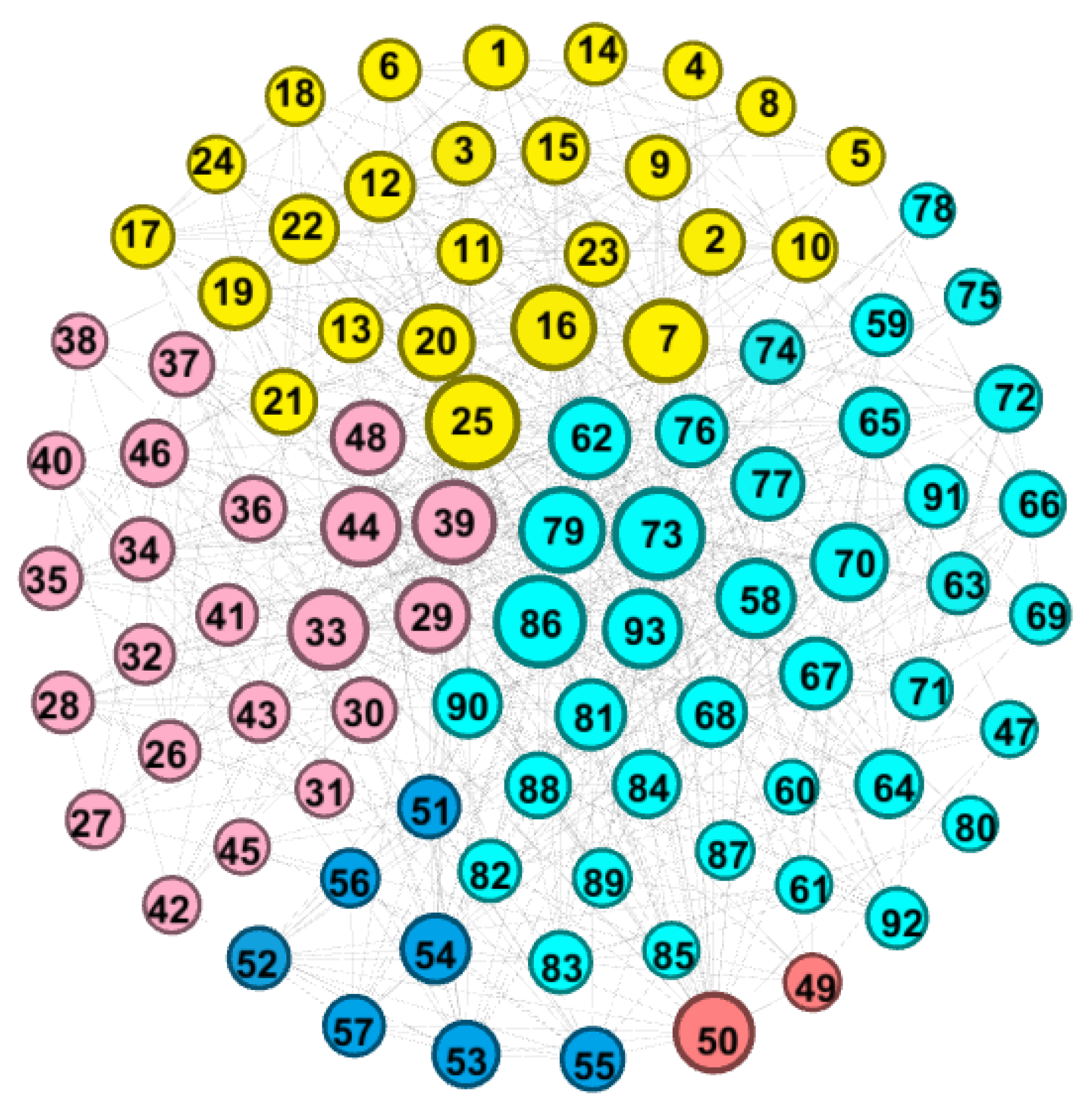

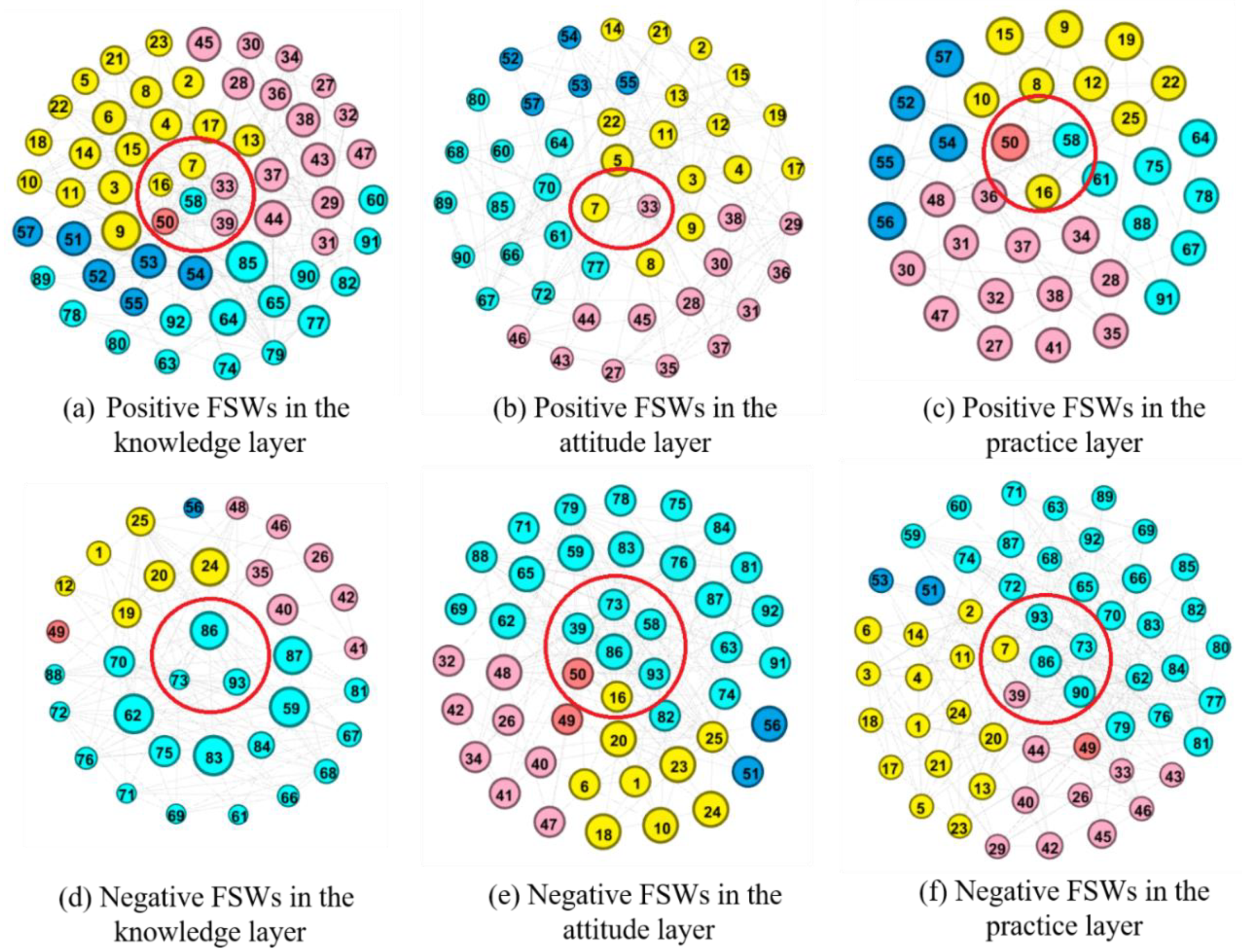
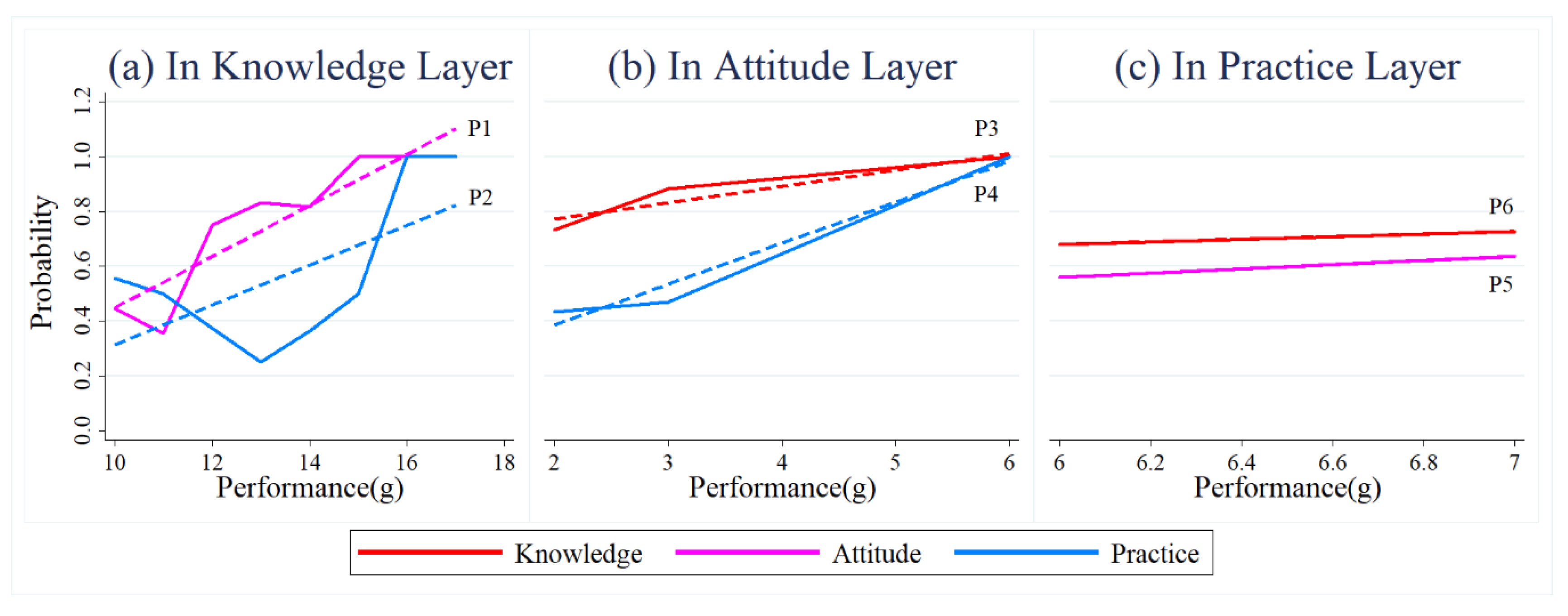



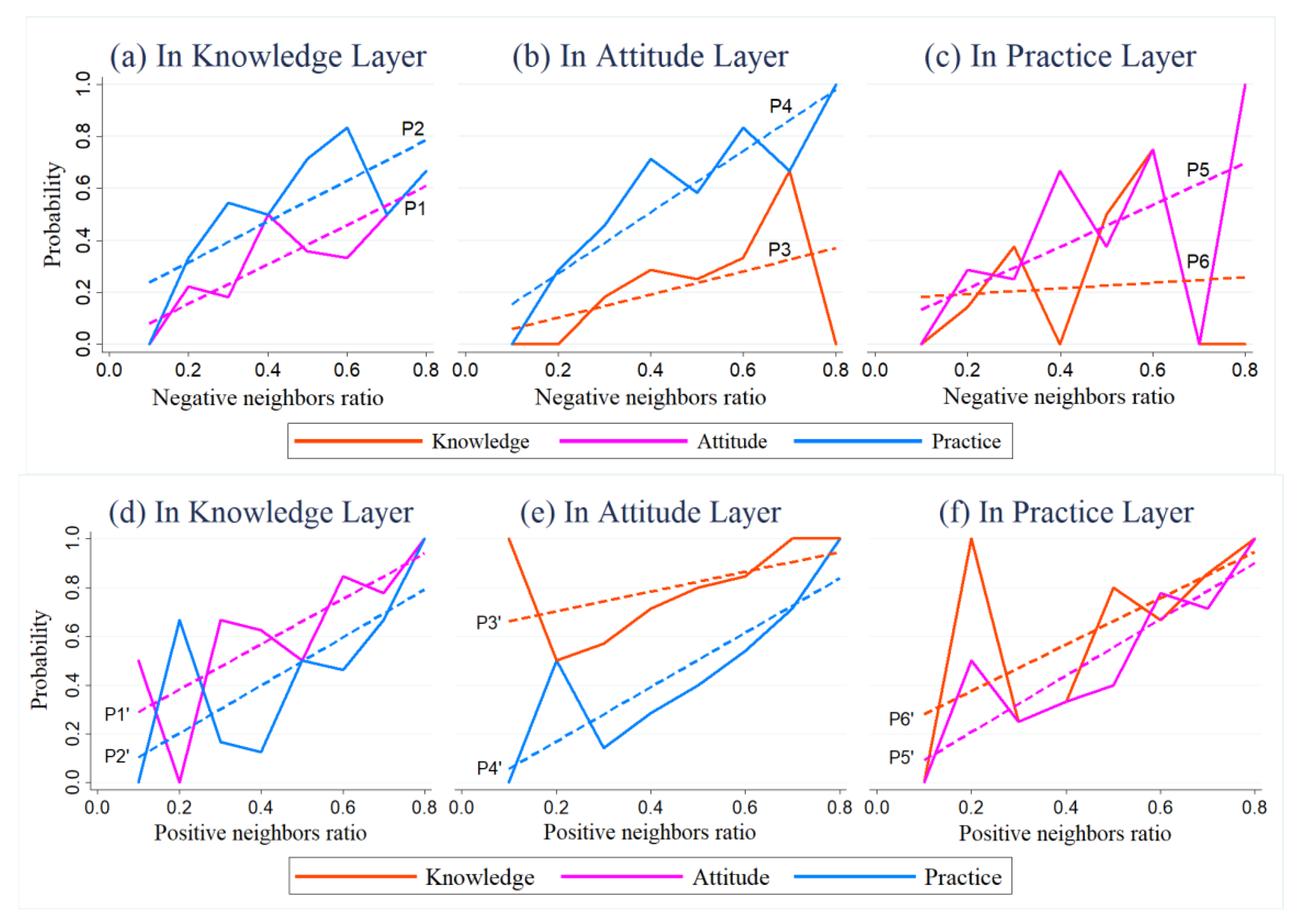
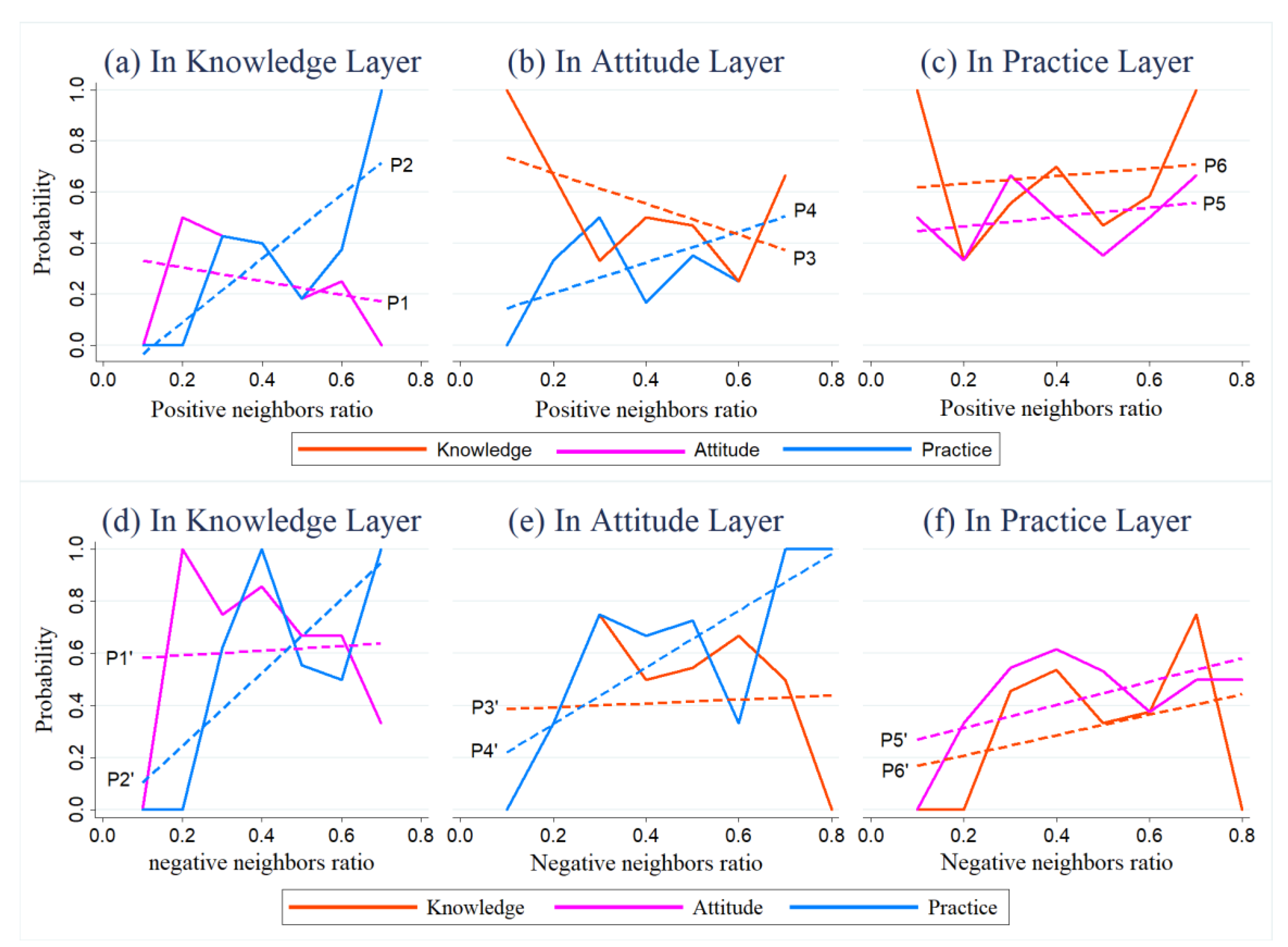
| Questions | Correct or Positive Answer | Correct or Positive, % |
|---|---|---|
| 1. Can sharing food with an HIV-infected person transmit HIV? | No | 59.14% |
| 2. Can shaking hands with an HIV-infected person transmit HIV? | No | 63.44% |
| 3. Can having sex without a condom with an HIV-infected person transmit HIV? | Yes | 90.32% |
| 4. In the last 12 months, have you received free condoms through free STI treatment? | Yes | 1.08% |
| 5. In the last 12 months, have you received free condoms through free HIV/STI counseling and testing? | Yes | 1.08% |
| 6. In the last six months, have you been tested for an STI? | Yes | 30.11% |
| 7. Even if a client offered more money, I could still insist on using a condom. | Yes | 86.02% |
| Categories | K + A + P | K + A | A + P | K + P | K | A | P |
|---|---|---|---|---|---|---|---|
| Positive FSWs | 16 | 22 | 5 | 9 | 10 | 6 | 6 |
| Negative FSWs | 19 | 6 | 10 | 6 | 5 | 9 | 22 |
| Sub-Layer | Bar or Karaoke Hall | Salon or Beauty Salon | Sauna or Massage Parlor | Nightclubs or Hotels | Other |
|---|---|---|---|---|---|
| Knowledge | 76% | 72.7% | 50% | 85.7% | 44.4% |
| Attitude | 64% | 63.6% | 0 | 71.4% | 36.1% |
| Practice | 36% | 59.1% | 50% | 71.4% | 22.2% |
© 2019 by the authors. Licensee MDPI, Basel, Switzerland. This article is an open access article distributed under the terms and conditions of the Creative Commons Attribution (CC BY) license (http://creativecommons.org/licenses/by/4.0/).
Share and Cite
Dong, X.; Sun, M.; Wang, J.; Yang, Z.; Hu, B. Understanding the Hierarchical Relationships in Female Sex Workers’ Social Networks Based on Knowledge, Attitude, and Practice. Int. J. Environ. Res. Public Health 2019, 16, 3841. https://doi.org/10.3390/ijerph16203841
Dong X, Sun M, Wang J, Yang Z, Hu B. Understanding the Hierarchical Relationships in Female Sex Workers’ Social Networks Based on Knowledge, Attitude, and Practice. International Journal of Environmental Research and Public Health. 2019; 16(20):3841. https://doi.org/10.3390/ijerph16203841
Chicago/Turabian StyleDong, Xianlei, Mengge Sun, Jingguo Wang, Zhihan Yang, and Beibei Hu. 2019. "Understanding the Hierarchical Relationships in Female Sex Workers’ Social Networks Based on Knowledge, Attitude, and Practice" International Journal of Environmental Research and Public Health 16, no. 20: 3841. https://doi.org/10.3390/ijerph16203841
APA StyleDong, X., Sun, M., Wang, J., Yang, Z., & Hu, B. (2019). Understanding the Hierarchical Relationships in Female Sex Workers’ Social Networks Based on Knowledge, Attitude, and Practice. International Journal of Environmental Research and Public Health, 16(20), 3841. https://doi.org/10.3390/ijerph16203841





